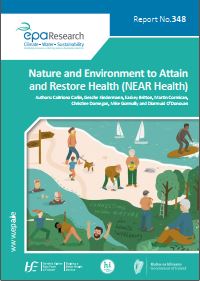Research 348: Nature and Environment to Attain and Restore Health (NEAR Health)
Authors: Caitríona Carlin, Gesche Kindermann, Easkey Britton, Martin Cormican, Christine Domegan, Mike Gormally and Diarmuid O’Donovan
Summary: The NEAR Health project was jointly funded by the EPA and the HSE to investigate how nature and environment can help society attain and restore health. It investigated (1) how people value and experience nature, health and wellbeing, (2) the barriers and bridges to connecting with nature, (3) what people want from their healthy future environment and (4) nature-based activities that benefit people’s health and wellbeing.

Environment and Health :: Environmental Protection Agency, Ireland
https://www.epa.ie/media/epa-2020/publications/research/Thumbnail_348.jpg